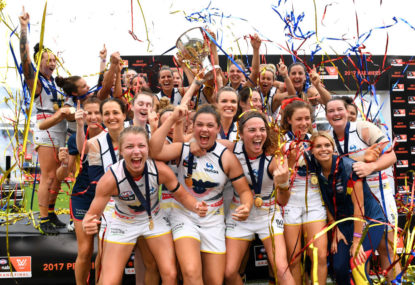The crucial cogs of AFL's Round 7: Which players need to be the difference makers?
We’re taking a look at one player from each team that needs to make a difference this week, starting with the ANZAC Day games.

Is the Adelaide Crows’ Bec Goddard a genius who figured out where the AFL Women’s (AFLW) standard was at and developed a style of play accordingly? Or is she a dinosaur who’s about to become extinct? The next several seasons may tell us.
When the AFLW started, it was clear that some coaches were determined to implement an elite style of play. There was just one problem – the talent level of most players wasn’t up to it. Modern football is possession football, and possession is more important than territory. You don’t just kick the ball forward at every opportunity if it risks giving up possession.
But in the AFLW’s first season there were only a handful of players on each team skilled enough to hit targets reliably under pressure, or to not fumble on the receiving end. Many teams would do what the AFLM does, and pass backwards under pressure, only to miss the kick and lose both territory and possession.
Worse still, some would try to switch play to the far side of the ground, tempted by the sight of all that open space and would more often than not give their opposition a juicy turnover in the corridor.
But not Bec Goddard. Goddard’s strategy was to kick it long and run like hell. If the only thing in the forward line was grass, so much the better.
She recruited players especially for the task, players who weren’t always the most skilful (outside Adelaide’s core of elite stars), but would run all day and charge at the loose ball like a Rottweiler at a postman.
She understood that in the AFLW Season 1, loss of possession was a given, so the team that could gain the most metres while still losing possession regularly would win. Only, did she really understand that?
In the women’s State of Origin game, Goddard seemed genuinely confident that her team had an equal chance of beating the Victorians, despite having almost no midfield by comparison.
Once again, her Allies kicked the ball long and ran like hell… and ran, and ran, and finally got to touch the ball again at the centre bounce after the Vics scored yet another goal, and often not even then. T
he final possession tally was outrageously lopsided – 385 to 204 – because once the Allies lost the ball, the Vics never gave it back.
In short, the Vics played modern football the way it’s meant to be played, and the way coaches like Michelle Cowan envisioned for Fremantle in season one but never had the playing list to execute.
With a midfield of Pearce, Blackburn, Kearney, Paxman, Eva, Donnellan, etc, the Vics were able to create chains of possession that allowed them to go wherever they wanted on the field. It doesn’t happen yet in the AFLW because those possession chains are only as strong as their weakest link, and thus far AFLW teams have too high a ratio of weak links to strong ones.
But in the State of Origin there were no weak links, and the Vics could go forward, backward, sideways, and almost unheard of in AFLW, successfully switch play to the fat side and make easy gains.
It’s hardly Goddard’s fault that the Allies lost – looking at those respective midfields it seemed like a done deal before the first bounce. But Goddard’s confident statements before the game will now be looked back on with raised eyebrows in some corners of the league.
Make no mistake – as AFLW depth increases, this is eventually going to be the way the game is played. And Bec Goddard, and any coaches thinking of adopting her tactics as a long-term strategy, will have to rethink how they do things.
Already there is one AFLW team who toward the end of the first season were starting to play this way, and that was the Melbourne Demons. It’s no accident that the Dees had the competition’s deepest midfield, with Pearce, Paxman, O’Dea and Mithen starring.
Midfields matter more in the AFLW than the AFLM because it takes the women that many more possessions to move the ball from one end of the ground to the other. More possessions equals more chances for those weak links to break the chain. Great forward lines are nice, but the Allies had a great forward line in the State of Origin game and found that it’s very hard to score when your midfield never gets you the ball.
If I were Melbourne I’d seriously consider stacking up on even more midfielders in the draft. If they could snag Monique Conti and Maddy Guerin, that would be six quality mids plus Kat Phillips on the wing, and some skilful backs and forwards.
Their forward line might lack a little scoring power compared to some, but if they’ve twice as many inside-50s as their opponents, and many more possessions, odds are they’ll win the game regardless.
In addition to his interest in sport, Joel Shepherd is a professional Science Fiction author. You can read more by him here.